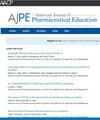虚拟特权行走活动的开发与评估。
IF 3.5
4区 教育学
Q1 EDUCATION, SCIENTIFIC DISCIPLINES
引用次数: 0
摘要
简介:特权散步可以鼓励对特权的自我反思,但可能会引起参与者的不适,因为他们观察到彼此之间的差异。目的:评估包含匿名虚拟特权行走的教学活动的有用性,以鼓励学生反思特权在医疗保健中的概念。方法:开发了30条特权行走语句,并将其构建为虚拟特权行走,以允许学生秘密地查看与整个队列比较的结果。虚拟特权行走和反思活动由药学一年级学生进行,而在此之前、之后和9个月后,学生们完成了16项包容性和压迫调查。本调查旨在衡量四个因素:1。2、对知识的信心和对包容的理解;2 .包容与压迫意识;3 .对药学咨询与医患一致性的看法;浅谈药师在促进和支持包容性中的作用。结果:对比教学活动前后的配对数据,活动后因子1、2、4较活动前显著升高,而活动后因子3较活动前降低。在活动结束9个月后再次完成调查的学生的数据显示,因素1有所增加,因素2和4没有变化,因素3有所下降。讨论:通过对特权行走的承担和反思,学生对药剂师在包容性支持中的作用的认识和理解的信心、认识和意见都有所提高。本文章由计算机程序翻译,如有差异,请以英文原文为准。
Development and Evaluation of a Virtual Privilege Walk Activity
Objective
Privilege walks can encourage self-reflection about privilege but may cause discomfort among participants as they observe disparities between one another. This study aimed to evaluate the usefulness of a teaching activity that included an anonymous virtual privilege walk to encourage students to reflect on privilege as a concept in health care.
Methods
A total of 30 privilege walk statements were developed and incorporated into a virtual privilege walk to allow students to confidentially view their results compared to the whole cohort. The virtual privilege walk and a reflective activity were undertaken by first-year student pharmacists. Students completed a 16-item inclusiveness and oppression survey before, immediately after, and 9 months following the activity. The survey was designed to measure 4 factors: (1) confidence in knowledge and understanding of inclusiveness; (2) awareness of inclusiveness and oppression; (3) opinions on pharmacy counseling and congruence between pharmacist and client; (4) opinions on pharmacists’ roles in promotion and support of inclusiveness.
Results
When comparing paired data before and after the teaching activity, there was a significant increase in factors 1, 2, and 4, but a decrease in factor 3 postactivity compared to preactivity. Data from students who completed the survey again 9 months after the activity showed an increase in factor 1, no change in factors 2 and 4, and a continued decrease in factor 3.
Conclusion
Confidence in knowledge and understanding of inclusiveness, awareness of inclusiveness, and opinions on the pharmacists’ role in supporting inclusiveness were all improved after students participated in and reflected on the privilege walk.
求助全文
通过发布文献求助,成功后即可免费获取论文全文。
去求助
来源期刊
CiteScore
4.30
自引率
15.20%
发文量
114
期刊介绍:
The Journal accepts unsolicited manuscripts that have not been published and are not under consideration for publication elsewhere. The Journal only considers material related to pharmaceutical education for publication. Authors must prepare manuscripts to conform to the Journal style (Author Instructions). All manuscripts are subject to peer review and approval by the editor prior to acceptance for publication. Reviewers are assigned by the editor with the advice of the editorial board as needed. Manuscripts are submitted and processed online (Submit a Manuscript) using Editorial Manager, an online manuscript tracking system that facilitates communication between the editorial office, editor, associate editors, reviewers, and authors.
After a manuscript is accepted, it is scheduled for publication in an upcoming issue of the Journal. All manuscripts are formatted and copyedited, and returned to the author for review and approval of the changes. Approximately 2 weeks prior to publication, the author receives an electronic proof of the article for final review and approval. Authors are not assessed page charges for publication.

 求助内容:
求助内容: 应助结果提醒方式:
应助结果提醒方式:


